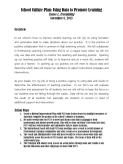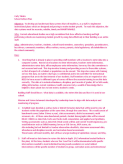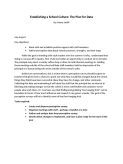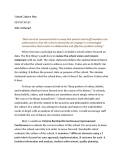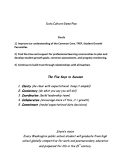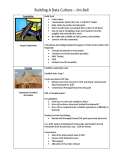Our class blog to capture assignments, thoughts and the conversations of the WSU Puyallup Assessment Of Learning class.
WSUP

8/30/15
8/27/15
Resource ~ AWSP Criterion 3 Rubric | Planning with Data
AWSP Leadership Framework & User's Guide
Criterion 3 Rubric | Planning with Data
Leading the development, implementation and evaluation of a data-driven plan for increasing student achievement, including the use of multiple student data elements.
Data refers to any type of information. Information or data can be represented numerically; data is also qualitative, the result from a relevant conversation with any stakeholder. Effective leaders rely on data to promote improvement in multiple aspects of school and across all of the eight Criteria. A leader influences others to achieve mutually-agreed upon purposes for the improvement of teaching and learning through consistent use of data. Acting on knowledge achieved through data becomes a cultural norm across the school.
|
Elements
|
UNSATISFACTORY
|
BASIC
|
PROFICIENT
|
DISTINGUISHED
|
3.1 Recognizes and seeks out multiple data sources
|
Does not recognize multiple sources or quality of data or has a limited understanding of the power and meaning of data
|
Seeks multiple sources of data to guide decision making; emerging knowledge of what constitutes valid and reliable sources of data and data integrity
|
Systematically collects valid and reliable data from at least three sources to be used in problem solving and decision making; builds capacity of staff to recognize information as data by providing examples of using data throughout the building and in staff meetings; systematically gathers data on grades, attendance, behavior and other variables to inform efforts
|
Is proficient AND explores and uses a wide variety of monitoring and data collection strategies; responds to an identified need for timely data by putting new data collection processes in place to collect reliable and valid data
|
3.2 Analyzes and interprets multiple data sources to inform school-level improvement efforts
|
Reviews and shares limited school-level data only as required; interpretation of data may be incorrect or incomplete; misuses data
|
Uses numerous data analysis methods and eager to broaden knowledge of data analysis and interpretation; uses school-level data to inform improvement across eight criteria
|
Analysis includes multiple years of data, including state, district, school and formal and informal classroom assessments; interprets available data to make informed decisions about strengths and areas of need; provides teacher teams with previous year’s data and asks them to assess students’ current needs
|
Is proficient AND consistently leads in data interpretation, analysis, and communication; links multiple years of student data to teachers and builds capacity of staff to understand and use their data for improved teaching and learning; practices a high standard for data reliability, validity and fairness and keeps these concepts in the forefront of conversations with staff
|
3.3 Implements data driven plan for improved teaching and learning
|
Plan is limited, not data driven and/or not aligned with the needs of the school; little stakeholder involvement and commitment
|
Plan is monitored, evaluated and revised resulting in data driven changes; works to build stakeholder involvement and commitment; models data-driven conversations in support of plan
|
Provides leadership such that plan is clearly articulated and includes action steps and progress monitoring strategies, and strategies in the plan are directly aligned with the data analysis process and are research based; leads ongoing review of progress and results to make timely adjustments to the plan; data insights are regularly the subject of faculty meetings and PD sessions
|
Is proficient AND creates a school culture of using data for decisions and continuous improvement in aspects of school life; orchestrates high-quality, low-stakes action planning meetings after each round of assessments; data driven plan specifically documents examples of decisions made on the basis of data analysis and results are documented to inform future decisions; provides assistance or coaching to other school administrators to improve their data driven plan and analysis
|
3.4 Assists staff to use data to guide, modify and improve classroom teaching and student learning
|
Does not assist staff to use data to reflect on effectiveness of lessons, guide lesson and assessment development, differentiate instruction, and to determine whether re-teaching, practice or moving forward is appropriate
|
Occasionally assists staff to use multiple types of data to reflect on teaching to determine whether re-teaching, practice or moving forward is appropriate; strategies result in incomplete relationship between the actions of teachers and the impact on student achievement
|
Regularly assists staff to use multiple types of data to reflect on effectiveness of lessons, guide lesson and assessment development, differentiate instruction (highly achieving as well as non-proficient) and to determine whether re-teaching, practice or moving forward with instruction is appropriate at both the group and individual level; strategies result in clear relationship between the actions of teachers and the impact on student achievement
|
Is proficient AND demonstrates leadership by routinely and consistently leading teachers to use multiple types of data to reflect on effectiveness of lessons, guide lesson and assessment development, differentiate instruction, and to determine whether re-teaching, practice or moving forward with instruction is appropriate at both the group and individual level
|
3.5 Provides evidence of student growth that results from the school improvement planning process*
|
School improvement planning process results in no improvement in student academic growth
|
School improvement planning process results in minimal improvement in student academic growth
|
School improvement planning process results in measurable improvement in student academic growth
|
School improvement planning process results in significant improvement in student academic growth
|
Resource ~ 9 Characteristics of High-Performing Schools
- A clear and shared focus
- High standards and expectations for all students
- Effective school leadership
- High levels of collaboration and communication
- Curriculum, instruction and assessments aligned with state standards
- Frequent monitoring of learning and teaching
- Focused professional development
- A supportive learning environment
- High levels of family and community involvement
Resource ~ Vision Statement Samples
RSD VISION STATEMENT
High Quality Instruction and Learning for EVERY Child, EVERY Day in EVERY Classroom and Environment
PSD VISION STATEMENT
We are a cohesive community passionate about learning, dedicated to the growth and development of each student served by a creative, forward -looking, and highly respected school district.
Updated:
TSD VISION STATEMENT
We will be an outstanding school district in which all students exhibit high standards of achievement and critical thinking skills, and are socially responsible, contributing members of their community.
BSD VISION STATEMENT ?
High Quality Instruction and Learning for EVERY Child, EVERY Day in EVERY Classroom and Environment
PSD VISION STATEMENT
We are a cohesive community passionate about learning, dedicated to the growth and development of each student served by a creative, forward -looking, and highly respected school district.
Updated:
Puyallup School District students will be:
- Skilled in successfully applying knowledge in all required subjects.
- Competent as critical and innovative thinkers able to analyze and solve complex problems.
- Engaged as life-long learners pursuing their goals and dreams.
- Successful as communicators and collaborators.
- Proficient in demonstrating an understanding of and a respect for individual differences.
- Prepared to transition to post-high school opportunities and be able to compete locally and globally.
- Skilled in making life choices that are healthy and socially responsible.
- Motivated to strive for excellence.
TSD VISION STATEMENT
We will be an outstanding school district in which all students exhibit high standards of achievement and critical thinking skills, and are socially responsible, contributing members of their community.
BSD VISION STATEMENT ?
With this mission in mind, we commit to the following:
- Bethel’s educational program will ensure that students learn and are able to effectively apply basic and advanced skills and processes in all academic areas.
- Bethel students will develop the skills needed to communicate their thoughts logically and effectively as well as to express their individuality and creativity.
- Bethel students will have the skills and abilities needed to meet the challenges of an information society and to utilize its rapidly changing technologies.
- Bethel students will demonstrate a basic understanding of our democratic process and the responsibility for citizenship in an international society.
- Bethel School District will promote an understanding and respect for the diversity of cultures and a recognition of the uniqueness of others in a pluralistic community.
- Bethel will provide an ongoing program of staff development which includes working with staff to incorporate a variety of teaching strategies that meet individual needs, help students discover information, gain knowledge, and to excel in academics, the arts and athletics.
- Bethel School District will provide a learning environment that prepares students to successfully transfer the knowledge, skills and attitudes learned in school to institutes of higher education and future careers.
Through the accomplishment of these commitments, students will be better prepared to participate as ethical, cooperative, responsible, and productive citizens.
The Bethel School District will work with parents, the business community, and the community at large as partners in the achievement of this mission.
WSU Student Support
As a WSU student you have free access to the WSU library search capabilities:
WSU Library support!
As well as support to help you improve your papers using the APA format:
Open Writing Lab Support!
WSU Library support!
As well as support to help you improve your papers using the APA format:
Open Writing Lab Support!
Resource ~ PSD CSIP Template
School Name
Comprehensive School Improvement Plan
School Year
1 Executive
Summary
A.
Mission/Vision
B.
Goals
C.
Activities
D.
Results
E.
Description/Reflection of 1Technology,
2Safety, and 3Parent Involvement progress
2 School Mission/Vision
3 School Data
4 School Goals
A.
Teacher Student Growth Goals
B.
Principal Student Growth Goals
C.
School Improvement Goals
a.
Elementary/Junior High School must include Math, Reading, Science Goals
b.
High School must include Math, Reading, and Graduation Rates
D.
Other Goals
a.
Title Goals
b.
LAP Goals
c.
Indistar Goals
d.
Other
5 School Activities/Initiatives
6 School Results
8/26/15
Assignment Due ~ 12/10 Assessment Portfolio
The portfolio
is a collection of 10 useful artifacts that relate to assessment for
principals. These artifacts may be materials provided in class by the
instructor or classmates. They should represent research or concepts in
assessment that will prove to be valuable in future administrative roles. Let's make a list of your Top 10 and drop that in Dropbox.
Assignment Due ~ 12/3 Leadership Plan
Students will develop a leadership plan that calendars ways in which their leadership
will be rooted in data-based decision making aimed at
improving culture, teaching, and learning. It should address those issues in a written form followed by a
calendar-specific plan that would benefit a practicing principal in
the area of assessment. The plan should be designed to serve as a
guide for you in your future roles as principal. Samples available on this blog.
Assignment Due ~ 11/19 School Data Culture Plan
Present a plan for using
formative and summative data to promote or improve a positive learning
environment. The plan should demonstrate
depth of knowledge of the TPEP framework, CCSS and student growth goals. This plan will focus on PLC’s, social
justice, and the role of leadership in creating a positive school culture. You will present this plan in class.
Criteria:
1) Quality of Content (TPEP,
CCSS, Student Growth Goals)
2) Applicability of the Plan in
terms of PLCs and Social Justice
3) Clear Statements about the
Role of the principal in implementation
4) Professional Communication
Assignments ~ Don't let them Sneak up on You
In addition to your weekly chapter and article reviews, interview summary and philosophy presentations you have 3 major projects to be thinking about:
1) Assessment Portfolio / Presentation ~ Due 12/10
This is our culminating project / presentation...You need to create and present a portfolio that contains 20 resources on assessment that will be pertinent for you in the future.
It must include at least:
10 One page Reflections about Course Content
10 Useful Artifacts that Relate to Assessment
2) Leadership Plan / Calendar / Presentation ~ Due 12/3
This is a guide or tickler file of critical events/milestones that support data-based decision making aimed at improving culture, teaching and learning. The plan should briefly address the issues in writing followed by a calendar specific plan. This plan will be presented in class.
3) School Data Culture Presentation ~ Due 11/19
This is a presentation / plan. How will you use formative and summative data to promote or improve a positive learning environment? How do TPEP, CCSS, student growth goals, PLC & social justice intersect and what is the role of the leader in creating a positive culture? Present your ideas and plan as if you were presenting to the school board.
DELETED ~ Assignment Due ~ 10/29 Student Growth Goal/TPEP Presentation
This Assignment is No longer Required
Create a Presentation to your staff that explains Student Growth Goal Setting/TPEP.
•Put your main concepts into a presentation you can share with your first staff.
•Prepare to share in small groups.
We'll use this rubric to give each other feedback on this assignment:
Content reflects thoughtfulness and completeness (depth)
1 2 3 4
Material is logically organized
1 2 3 4
Student Growth Goal Setting/TPEP is articulated clearly
1 2 3 4
Presentation reflects competence of the leader
1 2 3 4
How long should it be?
If we gave everyone 10 minutes it would take us over 2 hours to hear them all...which is why you'll be sharing in a smaller group and giving each other feedback. Think about how long you'd like to hear your principal talk about this topic at a staff meeting...that might help you plan the length. This assignment is intended to help you articulate what you know about this part of the work as it relates to the collection of data.
If we gave everyone 10 minutes it would take us over 2 hours to hear them all...which is why you'll be sharing in a smaller group and giving each other feedback. Think about how long you'd like to hear your principal talk about this topic at a staff meeting...that might help you plan the length. This assignment is intended to help you articulate what you know about this part of the work as it relates to the collection of data.
Assignment Due 10/22 ~ Science Fair Book Report
Create a 1 page handout with 16
copies… include the major highlights from your book.
Prepare a Science Fair Type
Poster board to Convince others to read the book.
Be prepared to present your book in 90 seconds.
Assignment Due ~ 10/8 Assessment Philosophy
Think about how you will answer these questions in an interview or with your staff:
What are your beliefs about the effective use of assessment?
What will you adhere to in your practice as a principal?
What are your non-negotiables?
What do you value most when establishing a culture of inquiry?
Put the main concepts into a presentation that you could share with your first staff.
What are your beliefs about the effective use of assessment?
What will you adhere to in your practice as a principal?
What are your non-negotiables?
What do you value most when establishing a culture of inquiry?
Put the main concepts into a presentation that you could share with your first staff.
Scoring
Rubric for Philosophy
of Assessment Presentation
To
what degree was ___________________’s “Philosophy of Assessment” effectively
presented?
Content
reflects thoughtfulness and completeness (depth)
1 2 3 4
Material
is logically organized
1 2 3 4
Philosophy
is articulated clearly
1 2 3 4
Presentation
reflects competence of the leader
1 2 3 4
Overall
Grade and Comments:
DELETED ~ Assignment Due 10/1 ~ 3 Page Reflection Paper "Usefulness of SIPs"
This Assignment is No Longer Required
Given what we’ve learned about SIP’s and the SIP process…
Given what we’ve learned about SIP’s and the SIP process…
Write
a Reflection Paper about the "Usefulness of School Improvement Plans".
Be
succinct ... 1-3 pages should do it. Use the TSC Reflection Process as a guide.
Assignment Due ~ 9/17 SIP/DIP Principal Interview Questions
Assignment: Interview a current school principal for the purpose of gaining their thoughts and discussing the processes and priorities they use to create a School Improvement Plan as required by state law.
Possible Interview Questions:Where did you start?
What questions did you ask?
Who did you consult?
Did you have any issues with teacher buy-in/ownership?What did you do?
What were your first priorities?
What types of data were your first priority?
Where did you look first and who did you first contact?
Who was/were your mentor(s) and what was the best advice he/she gave you?
How do you measure progress?
What indicators do you use to know if your CSIP plan is working?
What system did you put in place to monitor progress toward your goals?
How do you build on previous work?
Did you follow a template for your CSIP plan?
How are your building goals connected to the plan?May I have a copy?
How is the building vision and/or mission connected to the plan? May I have a copy?
Please post comments to this post if you have additional questions that may be helpful to others in our group.
Assignments ~ TSC Reading Reflection Format
For all chapter and reading reflection assignments we will use the "Triangle, Squares, Circle" method.
Grading Criteria:
1. Triangle After each reading, write down three important points from the presentation or reading.
2. Square Then, write down anything that “squares” with your thinking or anything you agree with.
3. Circle Finally, write down anything that is still “circling” in their head or questions you have.
2. Square Then, write down anything that “squares” with your thinking or anything you agree with.
3. Circle Finally, write down anything that is still “circling” in their head or questions you have.
Grading Criteria:
Thoughtfulness and Depth of Summary
Meaningful Application of Research for Peers
Application of “Triangle, Squares. Circle” Reflection
Rubric: For all Reflections
Meets Does Not Meet
Thoughtfulness and Depth of Reflections
|
Original reflections demonstrating significant depth and breadth of the topic
|
Predictable reflections demonstrating a lack of depth/breadth of the topic
|
Quality of Content
|
Clear, informative, and accurate
|
Lacks clarity, information, or accuracy
|
Professional Presentation
|
Organized and presented in an academic format using Standard American English
|
Lacks organization, academic format, or contains significant errors
|
Point of View
|
Written through the lens of a principal
|
Written through the lens of a teacher
|
Comments:
8/25/15
Resource ~ Bernhardt Provides Resources for Principals
Here's her Continuous Improvement Continuums. She provides a nice pdf with a CIC for schools that gives principals a rubric that evaluates your current culture. She examines 7 different elements using a 5 point rubric focused on your Approach, Implementation & Outcome for each. These are also in our text.
Resource ~ 10 Steps to Improving the Use and Value of Data
Another Great Resource for Culture Building from NASSP
~Principal Leadership, January, 2011
Nice article on principal leadership as it relates to data this could also help with your School Culture Assignment!
Here's a couple of simple quotes from the article:
- Develop a culture that embraces data.
- Collect data that provide a complete picture of the school’s climate for learning, including school variables that examine teacher-student and peer peer relationships, student and family engagement, school safety, and how the physical environment supports learning.
- Collect data that determine the present performance level of every student in the core curriculum and determine how students are performing in other areas that could affect their learning or school engagement.
- Collect student performance data that provide a complete picture of the whole child, including his or her academic, behavioral, social-emotional, and physical development.
- Convene professional learning communities or data dialogue teams to discuss and solve problems of practice.
- Have the teams review relevant student performance data and determine a course of action for solving problems that affect student and school performance.
- Monitor student progress in response to the implementation of interventions and programs addressing those problems.
- Evaluate intervention and program effectiveness and refine instruction, interventions, and data collection procedures as needed.
- Engage all school staff members, students, and families in reviewing and using data.
- Distribute student progress reports on a regular basis (e.g. monthly or quarterly) to all stakeholders to ensure continuity and ownership of student learning.
~Principal Leadership, January, 2011
Nice article on principal leadership as it relates to data this could also help with your School Culture Assignment!
Here's a couple of simple quotes from the article:
"Data must be communicated in a way that parents and staff members can understand so that the school community can engage in a meaningful conversation that results in collaborative and effective problem solving."
"Principals play an essential role in promoting the effective and efficient use of data for school improvement. Their leadership and priorities set a tone for how data will be used and embraced by teachers, students, and community members."
Resource ~ Data Use Toolkit for High School Principals
Here's another toolkit for High School Principal's
Early College Design's Data Use Toolkit
Early College Design's Data Use Toolkit
The Data Use Toolkit provides help to plan and implement activities and strategies for using data effectively. The Toolkit includes online resources to help those responsible for professional development to improve school and student performance. This includes school coaches, state and district education agencies, charter management organizations and school networks facilitated by intermediary organizations.
What distinguishes the Data Use Toolkit from other existing data tools is the focus on collecting, interpreting and acting on data elements related to the alignment of secondary and postsecondary teaching and learning. The Toolkit is a resource for supporting schools that blend college course taking in high school as a key design feature.
Resource ~ Using Data to Assess and Inform School Change
This resource might come in handy for those of you who will be doing your internship in a High School. It’s published by the College Board and NASSP.
This resource includes several short videos and even more activities to use with staff in developing a data culture…You may also get ideas for your School Culture assignment. I’ll also post it on our blog.
8/21/15
State Law ~ WAC on SIPs
The following requirements are hereby established by the
state board of education as related supplemental condition to a school
district's entitlement to state basic education allocation funds, as authorized
by RCW 28A.150.220(4).
(1) Current &
Valid Certificates.
Every school district employee required by WAC 181-79A-140
to possess an education permit, certificate, or credential issued by the
superintendent of public instruction for his/her position of employment, shall
have a current and valid permit, certificate or credential. In addition,
classroom teachers, principals, vice principals, and educational staff
associates shall be required to possess endorsements as required by WAC 181-82-105,
181-82-120,
and 181-82-125,
respectively.
(2) Annual School Building Approval.
(a) Each school in the district shall be approved
annually by the school district board of directors under an approval process
determined by the district board of directors.
(b) At a minimum the annual approval shall require
each school to have a school improvement plan that is data driven, promotes a
positive impact on student learning, and includes a continuous improvement
process that shall mean the ongoing process used by a school to monitor,
adjust, and update its school improvement plan. For the purpose of this section
"positive impact on student learning" shall mean:
(i) Supporting the goal of basic education under RCW 28A.150.210,
"…to provide students with the opportunity to become responsible citizens,
to contribute to their own economic well-being and to that of their families
and communities, and to enjoy productive and satisfying lives…";
(ii) Promoting continuous improvement of student
achievement of the state learning goals and essential academic learning
requirements; and
(iii) Recognizing nonacademic student learning and
growth related, but not limited to: Public speaking, leadership, interpersonal
relationship skills, teamwork, self-confidence, and resiliency.
(c) The school improvement plan shall be based on a
self-review of the school's program for the purpose of annual building approval
by the district. The self-review shall include active participation and input
by building staff, students, families, parents, and community members.
(d) The school improvement plan shall address, but is
not limited to:
(i) The characteristics of successful schools as
identified by the superintendent of public instruction and the educational
service districts, including safe and supportive learning environments;
(ii) Educational equity factors such as, but not
limited to: Gender, race, ethnicity, culture, language, and physical/mental
ability, as these factors relate to having a positive impact on student
learning. The state board of education strongly encourages that equity be
viewed as giving each student what she or he needs and when and how she or he
needs it to reach their achievement potential;
(iii) The use of technology to facilitate instruction
and a positive impact on student learning; and
(iv) Parent, family, and community involvement, as
these factors relate to having a positive impact on student learning.
(3) Nothing in this section shall prohibit a school
improvement plan from focusing on one or more characteristics of effective
schools during the ensuing three school years.
(4) School involvement with school improvement assistance
under the state accountability system or involvement with school improvement
assistance through the federal Elementary and Secondary Education Act shall
constitute a sufficient school improvement plan for the purposes of this
section.
(5) Nonwaiverable requirements. Certification requirements,
including endorsements, and the school improvement plan requirements set forth
in subsection (2) of this section may not be waived.
Subscribe to:
Posts (Atom)


